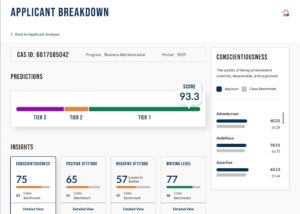More than two-thirds of admissions coordinators and counselors don’t stick around for more than three years, despite the positions’ key contact point between the institution and its potential students, according to a new report from College and University Professional Association for Human Resources.
“The Higher Ed Admissions Workforce: Pay, Diversity, Equity and Years in Position” collected data from more than 12,000 employees across 940 institutions, and it found that 71% of admissions officers and coordinators held their position for less than three years and averaged just two years at the position. With a median age of just 30 years, 76% of its workforce is under 40 years old.
Comparatively, only 44% of all higher ed professionals are under 40. Chief admissions officers and heads of admissions are on average 45 and 40 years old, respectively. They also had markedly lower rates of staff seasoned less than three years.
All in all, admissions coordinators and counselors—those responsible for recruiting, selecting and converting prospective students into a strong incoming class—are young and unlikely to stick around longer than what it takes for a student to finish a bachelor’s degree. These findings may not surprise you. CUPA-HR found in its 2017 report that 74% of coordinators and counselors held their positions for the same amount of time.
More from UB: College application essays: How to stop the lies
Reconceptualizing the workforce
CUPA-HR believes that the changing higher education landscape should motivate institutions to reconsider their current modalities.
“Colleges and universities would benefit from considering how they could reconceptualize crucial admissions positions, particularly coordinators and counselors, to encourage higher retention,” the report noted. “As institutions become more reliant on tuition dollars and prepare for the looming enrollment cliff, the value of admissions employees’ specialized skillset will likely continue to grow. Without strong enrollments, colleges and universities cannot thrive.”
Boost diversity and pay equity
Asian and Hispanic admission officers are poorly represented in comparison to the proportion of their respective races holding a U.S. bachelor’s degree. While Black people are represented well, representation of all people of color drops significantly from counselor or coordinator to head of admissions.
While pay equity in admissions is strong overall, Hispanic/Latino men are paid only 87 cents on the dollar to heads of admissions who are White men. And while the majority of chief admissions officers are Black or White women, they are paid less than White men in the same position.
Implement AI tools
Recent innovations in AI and machine-learning technology can do some serious heavy lifting for admissions officers and allow them to make decisions faster and with more confidence.
Student Select, a data science company dedicated to streamline the college admissions process, utilizes its machine learning model’s language processing components to create psychometric assessments of students based on their essays and personal statements. It then ranks a student’s probability of being accepted based specifically on what an institution is looking for in a student.
“There’s a lot of pressure to get this job done fast. The longer you wait to get those acceptance letters out, the more it impacts enrollment and the planning all around that,” said Will Rose, chief technology officer at Student Select. “A lot of pressure to get that all done in a timely matter. I can understand why they experience a lot of turnover in those areas.”
With higher education steadily dropping test-score and even GPA requirements from their application processes, admissions coordinators have to adapt to a more holistic, qualitative assessment of students, which can be particularly hard for applicants they are on the fence about. These 50/50 students require greater critical thinking and judgement from admissions coordinators.

The technology isn’t meant to make the decision; it’s organizing the pool of applicants into different categories of acceptance likelihood to help coordinators manage their time and priorities.
Seven schools use Student Select so far, including Rutgers and Rocky Mountain College in Montana.








